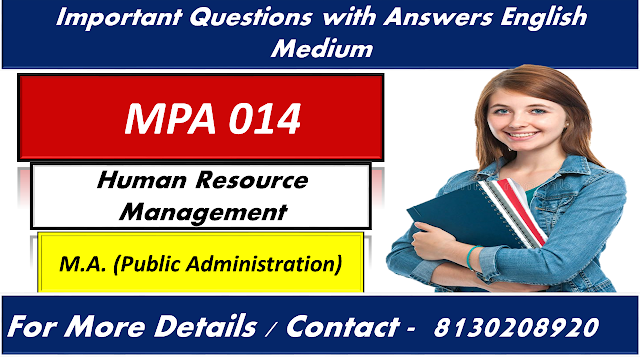IGNOU MPA 014 Important Questions With Answers English Medium
IGNOU MPA 014 Important Questions With Answers English Medium-MPA-014 Human Resource Management seems to be a course code
related to Human Resources (HR) in the context of a Master of Public
Administration (MPA) program.
Course
Structure:
- The meaning, nature, scope, and significance of human resource management
- Strategic human resource management
- Human resource planning and strategy
- Job analysis and job design
- Recruitment, selection, appointment, and promotion
- Performance appraisal
- Remuneration and salary systems
- Rewards and incentive management
- Employee benefits
- Training and development
- Redeployment and reskilling
- Learning and development
- Management development
- Employee capacity building strategies
- Total quality management
- Employee health and safety
- Human resource management and employment involvement
- Human resource management and industrial relations
- Discipline and grievances
- Assessing human resource management effectiveness
Q.1
Describe the different approaches to Strategic Human Resource Management.
Strategic Human Resource Management (SHRM) is a holistic
framework that aligns human resource practices with an organization's broader
strategic objectives. Over time, various approaches to SHRM have been
developed, each highlighting different facets of the intricate relationship
between human resources and organizational strategy.
IGNOU MPA 014 Important Questions With Answers English Medium-The resource-based view (RBV) is a foundational perspective that underscores the strategic importance of human resources as distinctive organizational assets. RBV posits that an organization's competitive advantage stems from unique and difficult-to-replicate resources, including human capital.
In the realm of SHRM, this approach underscores the significance of
effectively managing and utilizing human resources to establish a sustainable
competitive edge. Organizations embracing RBV channel efforts into recruiting,
training, and retaining skilled and motivated employees, creating a workforce
that is challenging for competitors to imitate.
Also Read-
- IGNOU MPA 011 Important Questions With Answers English Medium
- IGNOU MPA 012 Important Questions With Answers English Medium
- IGNOU MSOE 004 Important Questions With Answers English Medium
The configurational approach to SHRM emphasizes coherence and alignment between HR practices and organizational strategy. Rejecting the one-size-fits-all mentality, this approach advocates for tailoring HR practices to suit the specific needs and goals of the organization.
IGNOU MPA 014 Important Questions With Answers English Medium-Configurational SHRM
recognizes that the effectiveness of HR practices hinges on the congruence with
the overall strategy and structure of the organization. For instance, a company
pursuing cost leadership may prioritize efficiency in HR practices, while one
focused on differentiation might emphasize innovation and employee development.
This approach encourages HR managers to craft a bespoke HR system that aligns
with the organization's strategy, fostering internal consistency and alignment.
The integrative approach to SHRM underscores the need for
seamless integration of HR practices with the overarching strategic goals of
the organization. It seeks to dissolve traditional boundaries between HR and
other functional areas, insisting that HR decisions be intrinsically tied to
the broader business strategy. Integrative SHRM encourages collaborative
efforts between HR and other departments, fostering a holistic approach to
organizational success. By aligning HR practices with wider strategic goals,
organizations adopting this approach aim to enhance overall organizational
performance.
The dynamic capabilities perspective is an evolving approach to SHRM that acknowledges the dynamic nature of the business environment and the imperative for organizations to adapt continually. According to this perspective, organizations must cultivate the ability to sense changes in the external environment, seize new opportunities, and reconfigure their resources, including human resources, to respond effectively.
In the context of SHRM,
dynamic capabilities involve the capacity to adjust HR practices continuously
in response to evolving business conditions. This approach recognizes the
criticality of flexibility and agility in managing human resources,
particularly in industries marked by rapid technological advancements and
dynamic market conditions.
Q.2
“The use of concepts of learning and development are essential for organisational
efficiency.” Comment.
Q.3
Explain the meaning and importance of reskilling and highlight its process.
Q.4
“’Job enlargement and job enrichment play a very important role in job design
for Human Resource Management.” Elucidate.
Q.5
Explain the concept and requirements of manpower planning.
Q.6
Examine the methods of determining salary structure.
Q.7
Analyse the purpose of assessing human resource management effectiveness.
Q.8
Discuss the scope and significance of Human Resource Management.
Q.9
Explain the meaning, scope and importance of Human Resource Planning.
Q.10
What are the methods to ascertain merit ? Which do you prefer and why ?
Q.11
Examine the meaning and importance of Performance Appraisal.
Q.12
Highlight the importance of learning and development.
Q.13
What is Stress Management ? Discuss the strategies to control stress.
Q.14
Examine the role of Human Resource Department in evaluating human resource
effectiveness.
Q.15
Describe the approaches to managing change.







0 comments:
Note: Only a member of this blog may post a comment.